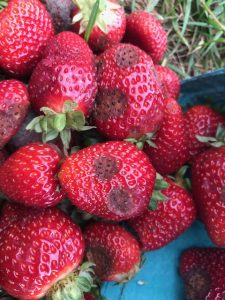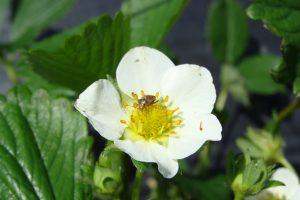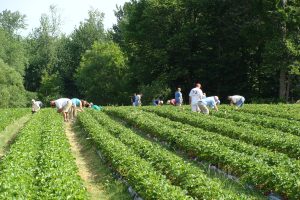Strawberry IPM Newsletter No. 5 — June 14, 2024
HARVEST SEASON UNDERWAY IN SOUTHERN MAINE
Anthracnose Fruit Rot Infecting Early Fruit
Situation: Southern strawberry fields will be opening this week or early next week. The crop size and quality looks very good in most fields. The predicted warm weather next week will hasten ripening, so if you haven’t started advertising yet, don’t wait. Most fields are past the point where clipper or tarnished plant bug could cause injury, and scouting should focus on pests that attack ripe fruit, such as sap beetles, slugs, birds, and anthracnose fruit rot. The Strawberry IPM Newsletter will take a couple of weeks off while we enjoy the harvest and will be back with our Renovation Issue in July.
Diseases: Fungicide sprays to protect strawberry fruit against gray mold may be needed in fields that had not received a fungicide spray in more than a week and/or had experienced more than one inch of rain since the last fungicide application.

Anthracnose Fruit Rot: We have had several reports of anthracnose fruit rot this week as growers begin to pick fruit for markets and stands. Be on the lookout for fruit showing dark brown or black sunken lesions with wet, orange (and sometimes gray) spore masses in them. Anthracnose is favored by warm, humid weather and can spread rapidly under rainy, wet conditions, especially if puddles remain in a field after the rain. The fungus is able to multiply on leaves without visible symptoms, which is why it may appear suddenly and widespread in a field. When spraying for fruit rots be sure to include products that are effective against anthracnose, including Cabrio®, Abound®, Luna Sensation®, Pristine® and Mervion.
Leather Rot (Phytopthora cactorum) is also a threat to fruit under wet conditions. Reports of dull-colored fruit with bitter flavor may indicate the presence of leather rot. The fruit is also tough and may have a pink or purplish tinge. Foliar sprays of Aliette®, Agri-Phos® or Phostrol® can provide control of this disease.
Powdery Mildew: Mild symptoms of powdery mildew can be seen in most fields with susceptible varieties. Discoloration of the fruit stems and caps may occur, in addition to the commonly seen leaf cupping. Fungicides registered for control include: Captan, Topsin-M®, Pristine®, or Cabrio®, or mix an effective gray mold product with a good powdery mildew product such as Quintec® or Procure®.
Sap Beetles: These insects have been found in several fields this spring. They are about 1/8 inch long, dark brown beetles, which chew small holes in ripening fruit. The damage allows rot organisms, such as Botrytis, to infect the fruit. Keep the field free of overripe fruit by picking often and thoroughly. Insecticide sprays for this pest can be effective but should be a last resort during the harvest period. Assail® Brigade®, Dibrom® and PyGanic® are registered for control of sap beetles with pre-harvest intervals ranging from 12 to 24 hours. Read the product label carefully for this and other application instructions and restrictions.

Tarnished Plant Bugs: Nymphs should only be a concern in late ripening fields that still have some bloom showing. Continue to scout any fields that have not yet received an insecticide application for the presence of plant bug nymphs. A spray should be applied if 4 or more flower clusters are infested with nymphs out of 30 sampled. Insecticide options for tarnished plant bugs include malathion, Assail®, Brigade®, Bifenture®, Dibrom®, Danitol®, Closer® and PyGanic®.
Two-Spotted Spider Mites: Populations remain below threshold, but are likely to increase under warm, dry weather conditions. At this point, control measures should wait until after harvest, unless populations become high enough to infest fruit. Continue to scout for mites and plan to manage any infestations as part of your bed renovation practices.
Review: Keeping Strawberries Fresh for Market
If you’re bringing fruit to market, make sure that it arrives in the best condition possible. Strawberries cool most efficiently if harvested early in the morning before they build up field heat. Place fruit into refrigerated storage quickly and keep it out of direct sunlight. Fruit should be stored at 32° Fahrenheit and 95% relative humidity. Cold air should be moved through the boxes or flats of fruit with a circulating fan and/or exhaust fan to cool most efficiently. Temperatures lower than 32° may freeze the fruit and ruin its fresh quality. A small, well-insulated building cooled with air conditioners and fans can provide effective temporary storage for strawberries. If you don’t have refrigeration facilities, keep the fruit as cool as possible by harvesting when air temperatures are cool, and keeping it out of direct sunlight. Transport the fruit to market as quickly as possible, and harvest only what you think you can sell in a day.
Annual Pre-Harvest Checklist for Pick-Your-Own

It’s that time again! As harvest approaches, we like to remind you to take a moment and make sure that your farm is prepared to give your customers an enjoyable experience. Take our annual review below to evaluate your customer readiness.
- Signs to the farm are neat and easy to read.
- There is easy access to the fields and plenty of parking.
- Someone is ready to greet customers and offer parking instructions and directions to the field.
- Access to the field is free of hazards.
- Transportation is provided for the elderly and disabled.
- The rules regarding picking are clearly posted.
- Someone is in the field to show customers where to pick and to answer questions.
- There are plenty of picking containers available.
- Clean restroom and hand washing facilities are available.
- Someone is available to help customers carry fruit out of the field.
- The checkouts are fast and efficient.
- Beverages are available.
- Shade and seats are available for customers wanting to rest.
- The help are friendly and knowledgeable.
A friendly, clean, and organized atmosphere will leave a lasting impression on your customers, encouraging them to come back and to recommend your farm to their friends.
You can also get quick access to this information through the UMaine Highmoor Farm news blog or the UMaine Pest Management web page.
Sincerely,
David T. Handley
Vegetable & Small Fruit Specialist
Highmoor Farm
P.O. Box 179
52 U.S. Route 202
Monmouth, ME 04259
207.933.2100
UMaine Extension Diagnostic Research Lab
Pest Management Unit
17 Godfrey Drive
Orono, ME 04473
1.800.287.0279
Where brand names or company names are used, it is for the reader’s information. No endorsement is implied nor is any discrimination intended against other products with similar ingredients. Always consult product labels for rates, application instructions and safety precautions. Users of these products assume all associated risks.
In complying with the letter and spirit of applicable laws and pursuing its own goals of diversity, the University of Maine System does not discriminate on the grounds of race, color, religion, sex, sexual orientation, transgender status, gender, gender identity or expression, ethnicity, national origin, citizenship status, familial status, ancestry, age, disability physical or mental, genetic information, or veterans or military status in employment, education, and all other programs and activities. The University provides reasonable accommodations to qualified individuals with disabilities upon request. The following person has been designated to handle inquiries regarding non-discrimination policies: Director of Equal Opportunity, 5713 Chadbourne Hall, Room 412, University of Maine, Orono, ME 04469-5713, 207.581.1226, TTY 711 (Maine Relay System).
